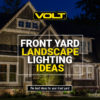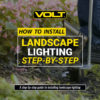Landscape lighting design can be a simple do-it-yourself project for most homeowners – but to the trained eye, there are some pitfalls to avoid. This article points out some common mistakes – and how to correct them.
Using the wrong fixture type for the application – Be careful to match your fixture type to the application. For example, use spotlights to accent individual objects or regions. Use floodlights to illuminate broad areas of walls or garden beds. Use well lights to hide the lights in turf areas or hardscapes. If you have a question on what type of fixtures to use, call our Customer Support line: 813-978-3700.
Blinding the viewer – Sounds extreme, but surprisingly this is one of the most common mistakes in landscape lighting. Ideally, whenever you install a fixture, it should not be positioned in a way that exposes the light source to the eye; that’s called direct glare. Direct glare causes visual discomfort and can obscure vision to the extent that the viewer is unable to see clearly for a period of time. To avoid direct glare, use spotlights and flood lights with glare shields and position the fixture so the shield effectively blocks the light source from viewers’ eyes. VOLT® fixtures are designed to minimize direct glare, but it is up to you, the designer to position them with this in mind.
Creating an airport runway – Have you ever seen lights along a path that remind you of an airport runway, lined up perfectly, one after another? This is not the effect we want. Instead, position lights in a zig zag pattern, alternating from one side of the path to the other. And, for curving paths, position lights in a way that follows the curve.
Using path lights that are the wrong size or style for the path – A short or narrow path should have smaller path lights. Also to consider, the architectural style of nearby structures. For modern styles, use path lights with classic or simple appearances. For more decorative structures, use the decorative style fixtures.
Unbalanced Lighting – The principal of balance refers to creating a harmonious relationship between two adjacent regions. For example, consider the left and right sides of a front yard as viewed from the road. Illumination on the left side should look good in relation to the illumination on the right side. That’s not to say they need to appear identical, but certain lighting themes should match – such as all trees lit on the left should be lit in the same way on the right. This principle of balance also relates to symmetry – such as using the same lighting technique on all columns along the front of the house.
Over-Illumination – To capture the essence of a nighttime landscape, lighting should be adjusted to as low a level as possible. The light of a full moon has a light level of only 0.01 foot candles – we all love that look. Typical path lights project a level that is 10 times the foot candles of moonlight. A typical spotlight projects over 100 times that level. The point being to keep light levels as low as possible while still satisfying the safety, security, and beauty goals of the design.






